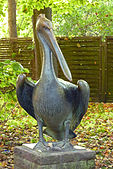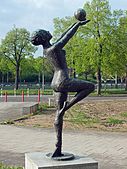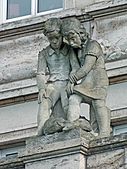Rudolf Oelzner
Rudolf Oelzner (born May 25, 1906 in Taucha , † September 9, 1985 in Leipzig ) was a German sculptor .
Live and act
Rudolf Oelzner was the son of the locksmith and blacksmith Franz Oelzner and his wife Martha. Since he was denied an apprenticeship as a baker because of his poor physical condition, the 14-year-old began an apprenticeship as a wood sculptor in a Leipzig workshop, which he completed in 1924. From 1926 to 1929 he studied at the State Academy for graphic arts and book trade in the class for sculpture with Alfred Thiele and in the workshops for book and stone printing of the same school with Georg Alexander Mathéy .
To finance the studies, he carried out various tasks. So he got to know the possibilities of concrete as a plastic material for his later work while working on the creation of the backdrops for the predator enclosures in the zoo using the cement casting process. The first small sculptures, animals, medals and sports prizes were created during his studies and in his first own studio from 1930 on Lutherstrasse in Leipzig. In 1931 he took part in an exhibition of the Leipziger Künstlerbund with two works, of which he was a member until its dissolution in 1934.
In 1938 he married his wife Liesbeth, née Dietrich. The following year his son Thomas was born, who became a popular model for him after World War II . At the end of 1939 Oelzner was called up for military service and came to France as a soldier. Here he met the sculptors Charles Despiau and Aristide Maillol , whose works influenced him for his later work, especially in the field of drawing. In 1944 he was taken prisoner by the British near Brussels, from which he was released in October 1945. His studio on Lutherstrasse had been destroyed in the war, and in 1947 he moved into one on Leibnizstrasse.
In 1946 his former teacher Alfred Thiele brought him to the reopened School of Applied Arts, which from 1947 was called the Leipzig School of Graphics and Book Art. Here he and Thiele headed the plastics department until 1952. From 1953 to 1954 he had a teaching position at the same facility for medal cutting, the special sculptural technique for designing bas-reliefs in medals. Disputes with the rector of the University of Applied Sciences Kurt Massloff about the proportions of intuition and scientific logic in artistic creation led to the discontinuation of teaching.
After that, Oelzner increasingly turned to design in public spaces. Together with Alfred Thiele, he created figural sculptures on the new buildings in the ring development and in Windmühlenstrasse. At the central stadium (“discus thrower award ceremony”) and at the DHfK (“javelin thrower”, “artistic gymnastics”, “torso lifting”) large-format depictions of athletes were created. He created depictions of animals for parks and the large bronze group "Family" in Leipzig's Karl-Liebknecht-Strasse.
He didn't just work with bronze and stone. Numerous terracotta works show his interest in fired clay. Several portrait busts were created using the cement casting process. But numerous drawings by him have also survived. His favorite motifs were animals on the one hand and nudes of women and boys as well as depictions of athletes on the other.
The flora figure made of white limestone, which was erected on his grave in Leipzig's southern cemetery six years after his death, was created after a model he made.
Works
In public space (selection)
- Groups of children and architectural sculptures on the Leipzig ring structure (with Alfred Thiele, 1954/1955)
- Discus thrower award ceremony , sculpture at the Red Bull Arena Leipzig (1957)
- Excited pelican , life-size bronze sculpture, Tierpark Berlin-Friedrichsfelde and Clara-Zetkin-Park Leipzig (1957)
- Bust Lumumba , in front of the former Herder Institute Leipzig (1961), stolen in 1997, replaced in 2011 by work by another artist
- The javelin thrower , artistic gymnastics and torso lifting , bronze sculptures in front of the Jahnallee university campus, formerly DHfK (1965/1966)
- Family , larger than life bronze sculpture, Karl-Liebknecht-Straße Leipzig (around 1970)
- Flora , sculpture on his grave in Leipzig's southern cemetery, based on an Oelzner model from 1952
In public collections
- Altenburg: Lindenau Museum
- Berlin: Sports Museum
- Hall: State Gallery Moritzburg
- Hamburg: Museum of Arts and Crafts
- Karlsruhe: Badischer Kunstverein
- Leipzig: Museum of Fine Arts , Grassi Museum , art collections of the university
- Magdeburg: Monastery of Our Dear Women
literature
- Rainer Behrends (Ed.): Rudolf Oelzner - sculptures, medals, models, drawings , custody of the University of Leipzig, 1997
- Katrin Löffler, Iris Schöpa, Heidrun Sprinz: Rudolf Oelzner . In: Der Leipziger Südfriedhof , Edition Leipzig, 2000, ISBN 3-361-00526-4 , p. 67
- Horst Riedel: Stadtlexikon Leipzig from A to Z . PRO LEIPZIG, Leipzig 2005, ISBN 3-936508-03-8 , p. 443
Web links
| personal data | |
|---|---|
| SURNAME | Oelzner, Rudolf |
| BRIEF DESCRIPTION | German sculptor |
| DATE OF BIRTH | May 25, 1906 |
| PLACE OF BIRTH | Taucha |
| DATE OF DEATH | September 9, 1985 |
| Place of death | Leipzig |








